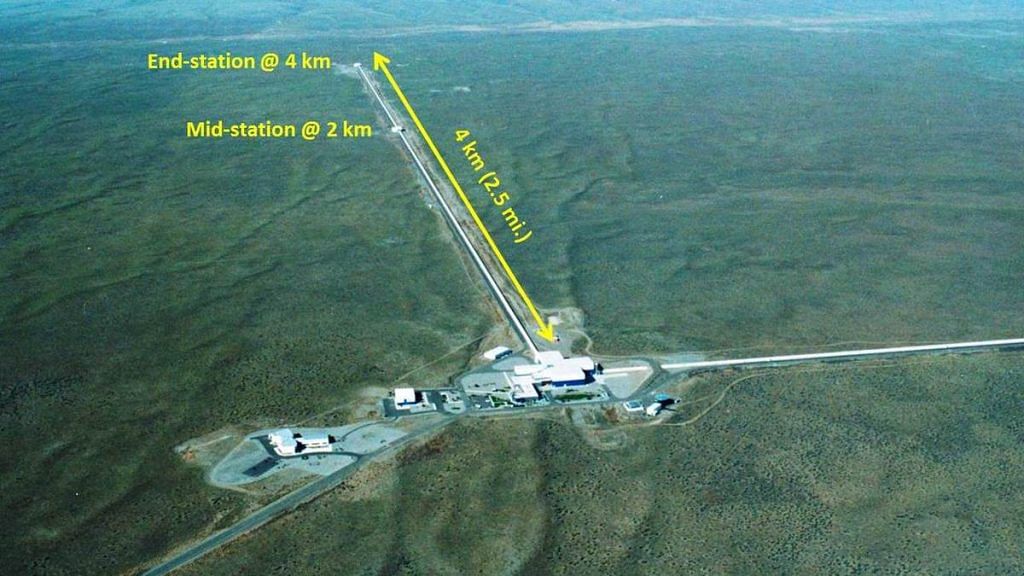New Delhi: The United States and India have jointly unveiled plans to construct a Laser Interferometer Gravitational-Wave Observatory (LIGO) in India, a major scientific alliance aimed at unravelling the mysteries of the universe.
The mega astronomy project, projected to cost Rs 2,600 crore, will study gravitational waves, which are often described as changes in the ‘fabric’ of the universe. The new observatory is expected to enhance scientific knowledge and astrophysics research not just in the country, but the world, and was among the US-India partnership initiatives hailed in PM Modi and President Biden’s joint statement last month.
The LIGO observatory in India will be built in Maharashtra’s Hingoli district, near the city of Aundha. The government has acquired 174 acres of land to set up the observatory, which is expected to be operational by 2030.
This will be the third LIGO site in the world. The first two are both in the US, one in the state of Washington and the other in Louisiana.
Considered an engineering marvel, LIGO, in very basic terms, comprises two 4-km-long vacuum tubes that work like antennae which can detect gravitational waves caused by massive events in space, such as black holes colliding.
Other similar instruments that detect gravitational waves include KAGRA in Japan and Virgo in Italy, both of which are smaller than LIGO and have 3-km arms.
According to experts, LIGO is also more powerful than other instruments of its kind.
“The LIGO detectors in the US are currently the most sensitive detectors. Other detectors are significantly lower in sensitivity, and some can even take several years to reach that point of efficacy,” said Sanjit Mitra, the LIGO-India project coordinator at the Pune-based Inter-University Centre for Astronomy and Astrophysics (IUCAA), to ThePrint.
“LIGO-India will use essentially the same design as the LIGO detectors in the US,” he added.
The LIGO-India project is a joint collaboration between the Government of India’s departments of atomic energy (DAE) and science and technology (DST), the National Science Foundation (NSF) in the United States, and several other national and international research and academic institutions.
In India, the four institutions leading the project include IUCAA, Gandhinagar’s Institute of Plasma Research (IPR), Indore’s Raja Ramanna Centre for Advanced Technology (RRCAT), and the Directorate of Construction, Services & Estate Management (DCSEM) under the DAE.
Also Read: How fast is universe expanding? Indian scientists may know a way to solve mystery using black holes
Why are gravitational waves important?
Gravitational waves are invisible ripples in spacetime that travel at the speed of light. They were first detected in September 2015 by both the LIGO observatories in the US.
Before that, most inferences about the universe were based on observations of electromagnetic energy.
Gravitational waves are made of energy and are released after major events involving the most massive bodies in the universe, such as the merging of black holes, massive stars exploding at the end of their lifetimes, and the collision of neutron stars.
“Gravitational waves allow us to observe the universe in a totally different way. Some phenomena, such as black hole collisions and the first moments after the Big Bang, can be observed only through gravitational waves. Gravitational-wave observations complement traditional astronomical telescopes,” explained Parameswaran Ajith, an astrophysicist at the International Centre for Theoretical Sciences under Mumbai’s Tata Institute of Fundamental Research (TIFR).
The study of gravitational waves dates back to 1916, when Albert Einstein proposed their existence in his theory of general relativity. However, Einstein thought that gravitational waves were just a mathematical curiosity. In the latter half of the twentieth century astronomers started discovering that violent collisions of neutron stars and black holes create waves that can be detected from Earth.
Studying gravitational waves can help uncover the history of the universe and understand many more complex mechanisms.
For example, earlier this year, Indian scientists proposed that gravitational waves emitted from black holes could help determine the rate of expansion of the universe.
They suggested that the multiple gravitational waves released from binary black holes reach Earth at various time stamps, which can be used to calculate the expansion rate of the universe.
How does LIGO work?
LIGO is essentially a massive L-shaped instrument, with each arm being 4 km long. Each arm encases a steel vacuum tube called an interferometer.
Laser pulses are shot through each arm and bounced back off a mirror at each end. A detector monitors the timing and movement of these pulses.
When a gravitational wave passes through the detector, the pulses will not return on time. Scientists can use this and other such signals to study gravitational waves.

LIGO is highly sensitive and can detect gravitational waves from distant galaxies, hundreds of millions of light years away.
For instance, the first gravitational wave observed by LIGO in 2015, according to the estimates of scientists, was caused by the collision of two black holes about 1.3 billion years ago.
LIGO-India: A new window to the cosmos
India’s new LIGO observatory will be the southernmost gravitational wave detector in the world, and is poised to make discoveries about the universe, according to experts involved in the project.
“Its unique geographical location has a huge impact on tracing the origins of various cosmic events in the sky,” said Karan Jani, a LIGO astrophysicist and research faculty member at US’ Vanderbilt University.
Jani, who is also involved in the LIGO-India project, added that this will aid in determining accurate locations.
Calling it one of the “most important astronomical observatories of the present era”, LIGO-India coordinator Mitra said this mega science project will create a platform for exchanging a great deal of knowledge.
“It will take the country forward not only in astronomy, but in developing various cutting-edge technologies,” he told ThePrint.
“I believe about two hundred people will be involved from four lead institutions executing the project. A much larger number of people from various academic institutions in India and abroad will also be involved in experimental research related to LIGO-India, including its future upgrades,” Mitra added.
According to Jani, LIGO will not just further scientific advancement, but also bring a diverse group of people together. He noted that the LIGO team is “particularly committed to training next-generation women scientists and historically underrepresented groups”.
“Our lab (at Vanderbilt) is designing a gravitational wave probe to put on the surface of the Moon by the next decade. I’m very excited about the possibility of black holes being measured jointly in LISA, LIGO-India, and the Moon,” said Jani.
LISA, short for Laser Interferometer Space Antenna, is a collaborative space-based gravitational wave mission between the European Space Agency (ESA) and NASA. The observatory is expected to be ready for launch in the mid-2030s.
This report has been updated to reflect that the LIGO project involving LISA will involve the lab at Vanderbilt University and not Ligo-India. The report has also been updated to more accurately reflect Einstein’s views on gravitational waves.
(Edited by Asavari Singh)
Also Read: Spinning stars help scientists detect nanohertz gravitational waves in universe for the first time



